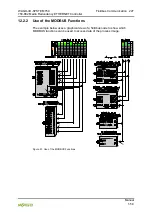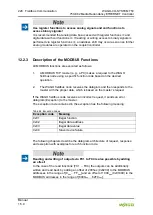
WAGO-I/O-SYSTEM 750
Fieldbus Communication 213
750-882 Media Redundancy ETHERNET Controller
Manual
1.5.0
Specification of the network mask necessary!
Specify the network mask defined by the administrator in the same way as the IP
address when installing the network protocol.
Gateway
The subnets of the Internet are normally connected via gateways. The function of
these gateways is to forward packets to other networks or subnets.
This means that in addition to the IP address and network mask for each network
card, it is necessary to specify the correct IP address of the standard gateway for
a PC or fieldbus node connected to the Internet. You should also be able to
obtain this IP address from your network administrator.
The IP function is limited to the local subnet if this address is not specified.
To communicate directly with each other, host and gateway must be on the same
subnet, that means the network ID must be the same.
RAW IP
Raw IP manages without protocols such as PPP (point-to-point protocol). With
RAW IP, the TCP/IP packets are directly exchanged without handshaking, thus
enabling the connection to be established more quickly.
However, the connection must beforehand have been configured with a fixed IP
address. The advantages of RAW IP are high data transfer rate and good
stability.
IP Multicast
Multicast refers to a method of transmission from a point to a group, which is a
point-to-multipoint transfer or multipoint connection. The advantage of multicast is
that messages are simultaneously transferred to several users or closed user
groups via one address.
IP multicasting at the Internet level is realized with the help of the Internet Group
Message Protocol IGMP; neighboring routers use this protocol to inform each
other on membership to the group.
For distribution of multicast packets in the sub-network, IP assumes that the
datalink layer supports multicasting. In the case of Ethernet, you can provide a
packet with a multicast address in order to send the packet to several recipients
with a single send operation. Here, the common medium enables packets to be
sent simultaneously to several recipients. The stations do not have to inform
each other on who belongs to a specific multicast address – every station
















































